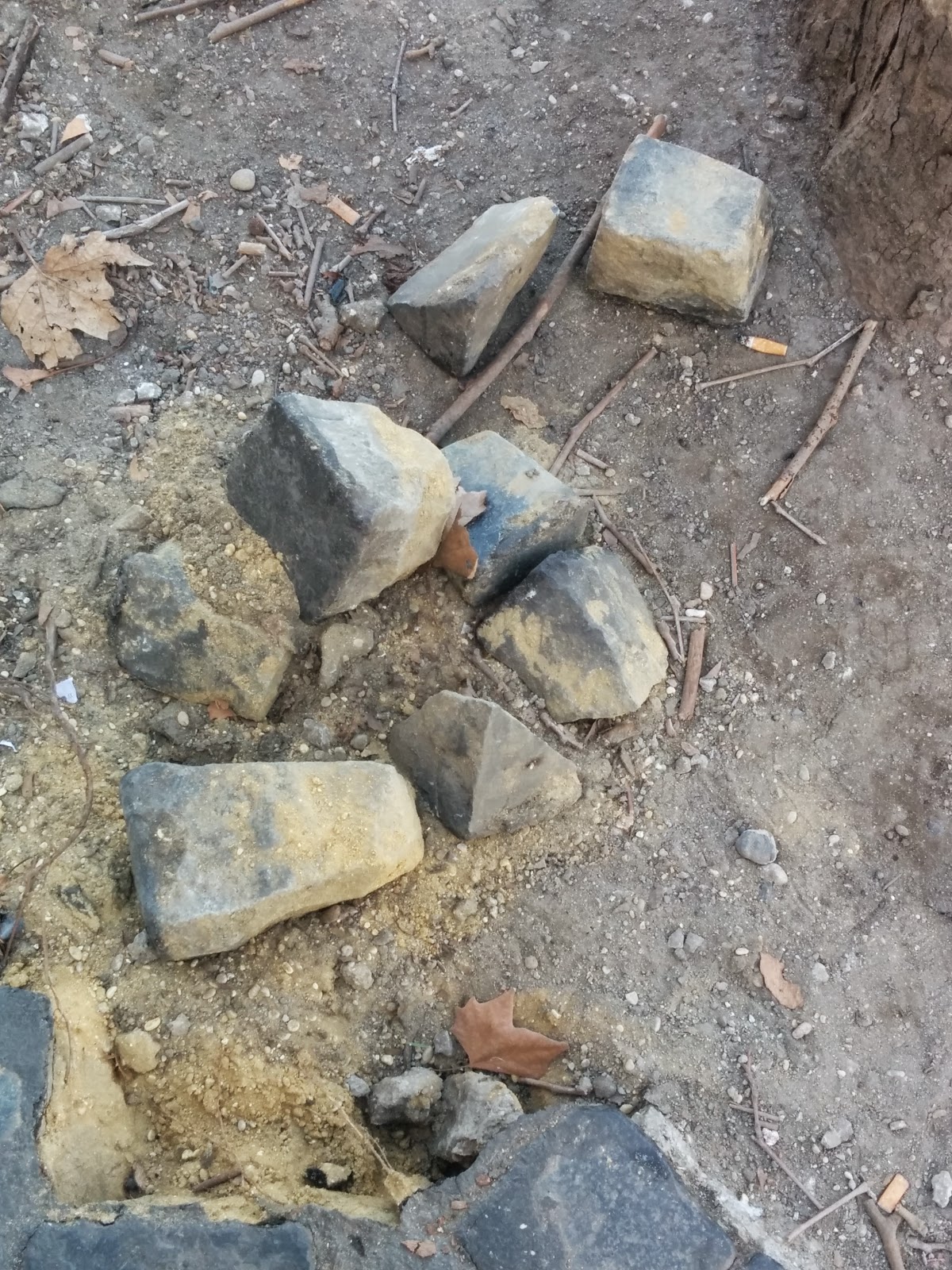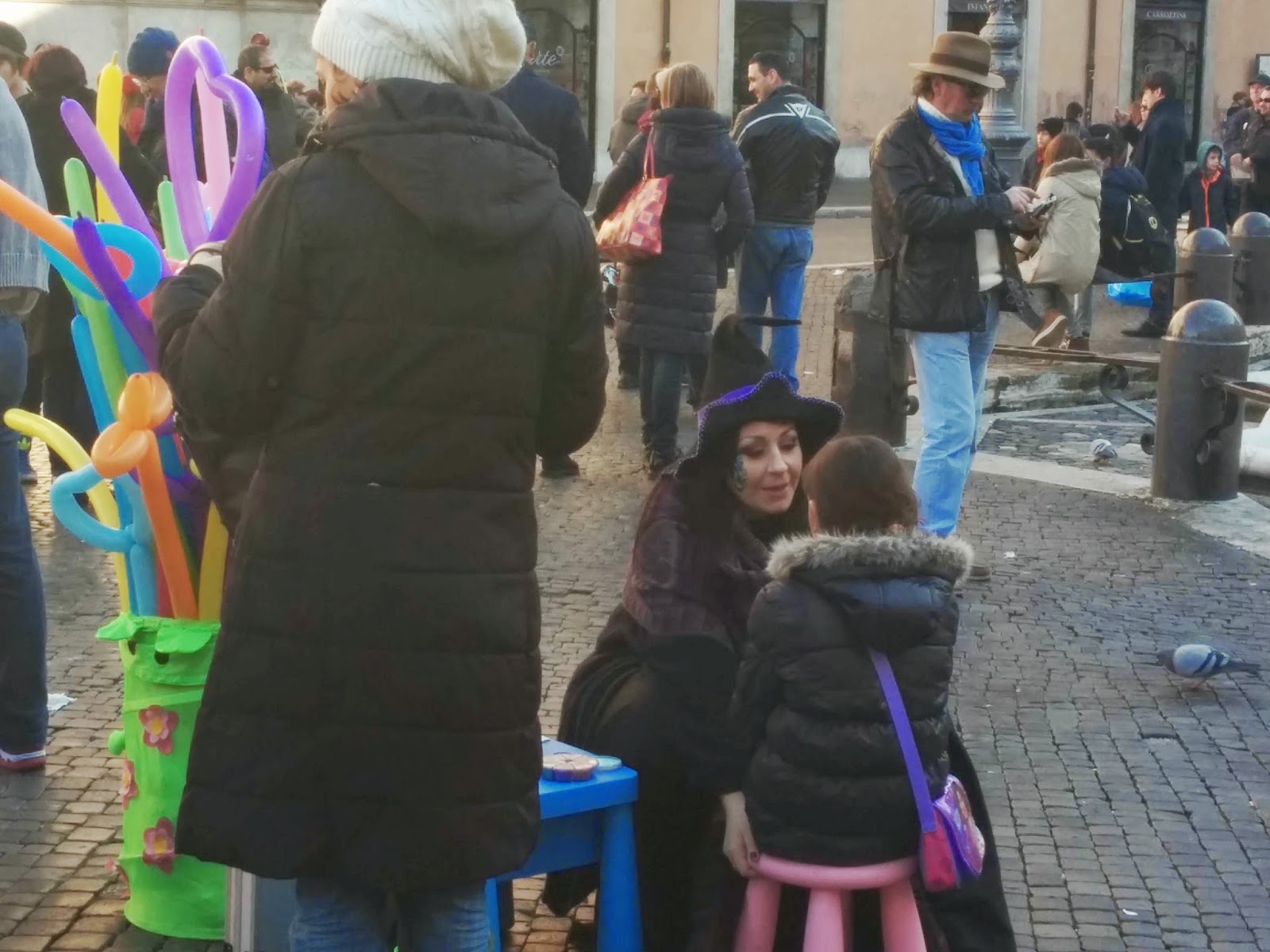Turner may have painted this live, standing on Aventine Hill. He was in Rome in 1830, the presumed date of this painting, his second visit there. Travel in his day was constrained by fighting between Britain and France. His first visit was delayed until 1818 (after Napoleon was defeated), and then he stayed in Italy for a couple years, traveling from north to south and back, and spending months in Rome. He drew and drew, filling notebooks which survive at the Tate Britain. Here's one drawing from a hill, made on that first trip:
Compare this drawing with the center section of the painting, under the tree. See the tower, the round temple, the hill between them covered with buildings. Turner stood further to the right to make this drawing, than he stood twelve years later to make the painting. He might even have been on a different hill, for instance Palatine Hill? Anyway, it's very interesting, and gives us a glimpse of his methods.
Julianne and I poked about on Aventine Hill. We asked - What did the scene actually look like in Turner's day? What has changed in the nearly 200 years since he painted it?
It's not clear we actually found his viewpoint, but we found a viewpoint, the Giardino degli Aranci, a beautiful park next to Santa Sabina church, filled with orange trees, fountains, and tall pines. It has about the same angle on the river as Turner had.
St. Peter's basilica, on the left in the distance. Right of the river, left of the tree, the little round temple of Hercules Victor, and above that on the horizon a tower that I can't quite put a name to, which is still there.
Behind and to the right of the tree, the ruins of the Forum. Over all, the glow of a golden morning. The beautiful haze on the river turns it silver; it seems to rise out of its bed to greet the sun.
Did he see the boulders and peasants in the foreground, or the houses and such on the near riverbank? Looks like Turner might have dramatized some elements. His hill looms higher than now. The lower-level cliffy waterfront with houses and whatnot appears more extensive than would have been possible given the actual space for them.
The long white building on the other side of the river in the painting, the Ospizio di San Michele, still exists (it's become the Ministry of Culture). But it's brick not marble, red-brown not white. There are dark old engravings of it.
About the bridge in the center distance, the Ponte Rotto. Here's a lesser artist's painting, from 1690. This artist is striving for architectural accuracy. If it's there, he puts it in, even the slummy waterfront, even the laundry. Since he's looking down-river from above the bridge, he sees Aventine Hill in the distance. Turner was looking up-river, standing on the hill.
"Tiber River with the Ponte Rotto and the Aventine Hill"
artist not cited in Wiki Commons
Turner's bridge spans the river -- but actually the Ponte Rotto was broken, with the east arches missing - they had been carried away by floods in 1575 and 1598. Later, in 1853, an iron extension was added to complete the bridge, but it weakened the stonework. Now it's just a stub, concealed by the steel bridge that replaced it in 1887. Demolition reduced the Ponte Rotto to a single arch, isolated like an island in the river.
And I must say, the rapids today are upriver from Turner's view, out of sight, touching the Isola Tiberina -- but we don't know whether the river was dredged and the rapids shifted, for instance when the new bridge was built, so let's give Turner the rapids.
Not to mention the sun, which seems to be rising in the north - never mind, cloud forms with sun are spectacular in Rome!
We can observe in the view of 1690 that Aventine Hill is very domesticated, with buildings everywhere. No broken boulders, no ruins. Of course, between 1690 and 1830, some ruins might have appeared. But I think Turner mainly made up the foreground of his painting.
Ah, Turner! This comparison is wonderfully permissive! Turner is a fabulous artist. He did what he liked with the elements of his design, to make the picture he wanted to see.
What Turner saw was something like what he painted, but he was far too Romantic in his vision to be hampered by mere accuracy!
And I must say, the rapids today are upriver from Turner's view, out of sight, touching the Isola Tiberina -- but we don't know whether the river was dredged and the rapids shifted, for instance when the new bridge was built, so let's give Turner the rapids.
Not to mention the sun, which seems to be rising in the north - never mind, cloud forms with sun are spectacular in Rome!
Clouds with setting sun, looking east from our apartment
We can observe in the view of 1690 that Aventine Hill is very domesticated, with buildings everywhere. No broken boulders, no ruins. Of course, between 1690 and 1830, some ruins might have appeared. But I think Turner mainly made up the foreground of his painting.
Ah, Turner! This comparison is wonderfully permissive! Turner is a fabulous artist. He did what he liked with the elements of his design, to make the picture he wanted to see.
What Turner saw was something like what he painted, but he was far too Romantic in his vision to be hampered by mere accuracy!
If we turn to the present, it's hardly the same view, so much has changed since Turner's day!
The little port on the left of the painting is gone. Both banks of the river have been built up to hold back floods. There's a concrete walkway along the water now, with cars and buses moving above on the built-up streets. Trees line the streets and mainly conceal the view of the river from Aventine Hill. Any housing along the near bank has been cleared away in favor of a 4-lane asphalt thoroughfare. The temple to Hercules Victor is there in a very nice park, but buried in trees from our sight.
The little port on the left of the painting is gone. Both banks of the river have been built up to hold back floods. There's a concrete walkway along the water now, with cars and buses moving above on the built-up streets. Trees line the streets and mainly conceal the view of the river from Aventine Hill. Any housing along the near bank has been cleared away in favor of a 4-lane asphalt thoroughfare. The temple to Hercules Victor is there in a very nice park, but buried in trees from our sight.
My watercolor of Turner's view
View of the Tiber from Aventine Hill
Consider the skyline. The main synagogue that now dominates the center of the scene above the bridge was built in 1901-04, after the nation of Italy had taken over from the papacy and the ghetto was opened. People could move around into Rome as citizens, and despite the terrible hiccup in the 1940s, the synagogue is a major landmark today.
To the right is another landmark that wasn't there 185 years ago, the Monumento Nazionale a Vittorio Emanuele II, huge, white, towers at each end supporting giant sculptures of Winged Victory driving 4 horses. Totally grand, makes your heart sing to see it, built by Mussolini. I wish we could erase that last bit, but there it is, Mussolini did a lot of building in Rome. In Turner's day, the autocrat doing the building was the Pope.
And, Aventine Hill itself looks more like the 1690 view in fact. Turner shows piles of boulders - we see major terracing and retaining walls supporting churches, monasteries, and houses.
One cannot be sure of Turner's report - he liked rocky scenes, was fascinated by mountains and crags - but who knows? There might have been a rock or two up there. Now we have a dramatic brick and stone overlook with terraces below. The view below is mid-winter.
One cannot be sure of Turner's report - he liked rocky scenes, was fascinated by mountains and crags - but who knows? There might have been a rock or two up there. Now we have a dramatic brick and stone overlook with terraces below. The view below is mid-winter.

Think of all the things we take for granted that Turner never saw - asphalt roads, chain-link fencing, electric lights, motor vehicles, heavy equipment, photography.
Turner squinted and waved his hands, drew and drew, and saw Romance. He made hundreds of drawings and watercolors that were then engraved to illustrate books and magazines - a major source of income for him. He cribbed from his notebooks for years.
Today our notes are photographic. We can't get away from the clarity of an exact line. Precision and efficiency, the hallmarks of manufacturing, obliterate the Romantic impulse.
But, is that true? Turner's main subject, as he developed over the years, was light. Or perhaps more accurate to his perception, Light. Light is the subject of photographs. Light the topic of watercolor. Light the milieu for art glass. Light the essence of emotion in art. Never mind all that stuff about subject, the subject (if any) is vision itself. Everything else follows.




































